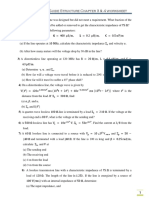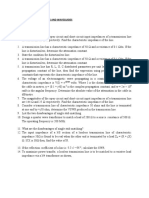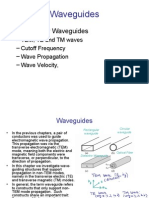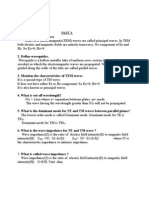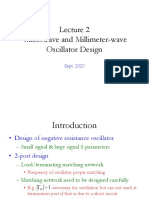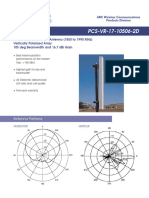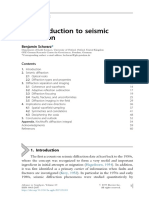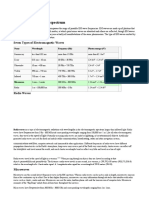0 ratings0% found this document useful (0 votes)
77 viewsMicrowave Practice Problem
Microwave Practice Problem
Uploaded by
ritikThis document contains 10 questions about microwave engineering concepts related to rectangular and circular waveguides. The questions cover topics such as determining cutoff frequencies, phase and group velocities, wavelengths, modes, power levels, and field intensities for various waveguide configurations operating at different frequencies. Mathematical calculations are required to answer questions about waveguide dimensions, frequencies, field values, and power handling capabilities.
Copyright:
© All Rights Reserved
Available Formats
Download as PDF, TXT or read online from Scribd
Microwave Practice Problem
Microwave Practice Problem
Uploaded by
ritik0 ratings0% found this document useful (0 votes)
77 views2 pagesThis document contains 10 questions about microwave engineering concepts related to rectangular and circular waveguides. The questions cover topics such as determining cutoff frequencies, phase and group velocities, wavelengths, modes, power levels, and field intensities for various waveguide configurations operating at different frequencies. Mathematical calculations are required to answer questions about waveguide dimensions, frequencies, field values, and power handling capabilities.
Original Title
microwave practice problem
Copyright
© © All Rights Reserved
Available Formats
PDF, TXT or read online from Scribd
Share this document
Did you find this document useful?
Is this content inappropriate?
This document contains 10 questions about microwave engineering concepts related to rectangular and circular waveguides. The questions cover topics such as determining cutoff frequencies, phase and group velocities, wavelengths, modes, power levels, and field intensities for various waveguide configurations operating at different frequencies. Mathematical calculations are required to answer questions about waveguide dimensions, frequencies, field values, and power handling capabilities.
Copyright:
© All Rights Reserved
Available Formats
Download as PDF, TXT or read online from Scribd
Download as pdf or txt
0 ratings0% found this document useful (0 votes)
77 views2 pagesMicrowave Practice Problem
Microwave Practice Problem
Uploaded by
ritikThis document contains 10 questions about microwave engineering concepts related to rectangular and circular waveguides. The questions cover topics such as determining cutoff frequencies, phase and group velocities, wavelengths, modes, power levels, and field intensities for various waveguide configurations operating at different frequencies. Mathematical calculations are required to answer questions about waveguide dimensions, frequencies, field values, and power handling capabilities.
Copyright:
© All Rights Reserved
Available Formats
Download as PDF, TXT or read online from Scribd
Download as pdf or txt
You are on page 1of 2
Unit-1
Important Question (10)
Subject-Microwave Engineering (BEC-34)
1. An air-filled rectangular waveguide of inside dimensions 7Cm x 3.5 Cm operates in the
dominant TE10 mode as shown in Fig. (a=7Cm, b=3.5Cm)
Figure: Rectangular waveguide
a. Find the cut off frequency.
b. Determine the phase velocity of the wave in the guide at a frequency of 3.5 GHz.
c. Determine the guided wavelength at the same frequency.
2. An air-filled waveguide with a cross section 2 Cm x 1 Cm transports energy in the TE10
mode at the rate of 0.5 hp. The impressed frequency is 30 GHz. What is the peak value of the
electric field occurring in the guide? (a=2Cm ,b=1Cm )
Figure: Rectangular waveguide
3. A TE11 mode is propagating through a circular waveguide. The radius of the guide is 5 Cm,
and the guide contains an air dielectric.
a. Determine the cut off frequency.
b. Determine the wavelength A8 in the guide for an operating frequency of 3 GHz.
c. Determine the wave impedance Z8 in the guide.
4. An air-filled circular waveguide has a radius of 2 Cm and is to carry energy at a frequency
of 10 GHz. Find all the TEnp and TMnp modes for which energy transmission is possible.
5. An air-filled rectangular waveguide has dimensions of a = 6 Cm and b = 4 Cm. The signal
frequency is 3 GHz. Compute the following for the TE10, TE01, TE11, and TM11 modes: a. Cut
off frequency b. Wavelength in the waveguide c. Phase constant and phase velocity in the
waveguide d. Group velocity and wave impedance in the waveguide.
6. The dominant mode TE10 is propagated in a rectangular waveguide of dimensions a = 6 Cm
and b = 4 Cm. The distance between a maximum and a minimum is 4.47 Cm. Determine the
signal frequency of the dominant mode.
7. A rectangular waveguide is designed to propagate the dominant mode TE10 at a frequency
of 5 GHz. The cut off frequency is 0.8 of the signal frequency. The ratio of the guide height to
width is 2. The time-average power flowing through the guide is 1 kW. Determine the
magnitudes of electric and magnetic intensities in the guide and indicate where these occur in
the guide.
8. An air-filled rectangular waveguide with dimensions of 3 Cm x I Cm operates in the TE10
mode at l0 GHz. The waveguide is perfectly matched and the maximum E field existing
everywhere in the guide is 103 V/m. Determine the voltage, current, and wave impedance in
the waveguide.
9. The dominant mode TE10 is propagated in a rectangular waveguide of dimensions a = 2.25
Cm and b = I Cm. Assume an air dielectric with a breakdown gradient of 30 kV/cm and a
frequency of l0 GHz. There are no standing waves in the guide. Determine the maximum
average power that can be carried by the guide.
10. A rectangular waveguide is filled by dielectric material of E, = 9 and has inside dimensions
of 7 x 3.5 Cm. It operates in the dominant TE10 mode.
a. Determine the cut off frequency.
b. Find the phase velocity in the guide at a frequency of 2 GHz.
c. Find the guided wavelength A8 at the same frequency.
You might also like
- Sound Revision WorksheetDocument6 pagesSound Revision WorksheetCraft City100% (4)
- Home Assignment On WaeguideDocument2 pagesHome Assignment On WaeguideTsG gHoSt oP100% (1)
- EM Waves and Guide Structure Chapter 3 & 4 WorksheetDocument5 pagesEM Waves and Guide Structure Chapter 3 & 4 WorksheetAbrham GojjamNo ratings yet
- Mwe 18u01030Document15 pagesMwe 18u01030SANDA ADITYA VARDHANNo ratings yet
- Home Assignment-10: Electromagnetic Theory (EE340)Document1 pageHome Assignment-10: Electromagnetic Theory (EE340)shivanshu100% (1)
- MWRE Unit 1 Reference Problems PDFDocument12 pagesMWRE Unit 1 Reference Problems PDFERMIAS AmanuelNo ratings yet
- MWRE Unit 1 Reference Problems PDFDocument12 pagesMWRE Unit 1 Reference Problems PDFERMIAS Amanuel100% (1)
- A5 PDFDocument1 pageA5 PDFChandra Kanth PamarthiNo ratings yet
- Win16 17da3 QuestionsDocument2 pagesWin16 17da3 QuestionsThennarasu RamachandranNo ratings yet
- Microwave Tut.2Document1 pageMicrowave Tut.2rochakjyotiNo ratings yet
- Transmission Lines and Waveguides Question BankDocument6 pagesTransmission Lines and Waveguides Question BankCyril Robinson Azariah JCNo ratings yet
- Emf 2015Document2 pagesEmf 2015nandakumari.aeNo ratings yet
- Mwe CF PDFDocument67 pagesMwe CF PDFSailesh HanumanthulaNo ratings yet
- Assignment Topics: Dominant ModeDocument67 pagesAssignment Topics: Dominant ModeXyzNo ratings yet
- Assignment11 PDFDocument4 pagesAssignment11 PDFmanishNo ratings yet
- Microwave Systems (10EC74) Assignment Set - 8Document3 pagesMicrowave Systems (10EC74) Assignment Set - 8VivekNo ratings yet
- Assignment 1 PDFDocument1 pageAssignment 1 PDFhelloNo ratings yet
- Assignemnt - 3 - On - Wave Guide and WG ComponentsDocument2 pagesAssignemnt - 3 - On - Wave Guide and WG ComponentsHARSHITHANo ratings yet
- Important Questions From Microwave Engineering (REC-601) : o SH 11 R RDocument3 pagesImportant Questions From Microwave Engineering (REC-601) : o SH 11 R RAkanksha BhadauriaNo ratings yet
- Assignment 1 - EC3201 - Microwave EngineeringDocument1 pageAssignment 1 - EC3201 - Microwave EngineeringVasudev DwivediNo ratings yet
- Emf 2016Document2 pagesEmf 2016nandakumari.aeNo ratings yet
- 5Document5 pages5Kazirul LatifNo ratings yet
- MWE QN - BNKDocument5 pagesMWE QN - BNKAgastya SinghNo ratings yet
- Experiment No.1 Rectangular Waveguide Design Using CST Microwave Studio SuiteDocument3 pagesExperiment No.1 Rectangular Waveguide Design Using CST Microwave Studio Suiteali salehNo ratings yet
- Mwe - QPDocument4 pagesMwe - QPashokvaasanNo ratings yet
- WaveguidesDocument18 pagesWaveguidesVikram SinghNo ratings yet
- Emf Final (2014)Document2 pagesEmf Final (2014)nandakumari.aeNo ratings yet
- Part ADocument2 pagesPart Asotify249No ratings yet
- PH0101 Unit 2 Lecture 4: Wave Guide Basic Features Rectangular Wave Guide Circular Wave Guide ApplicationsDocument32 pagesPH0101 Unit 2 Lecture 4: Wave Guide Basic Features Rectangular Wave Guide Circular Wave Guide ApplicationsShubham Gupta100% (1)
- Experimental Mode Content Analysis For Coplex Overmoded Waveguire Systems - Cepni Et AlDocument4 pagesExperimental Mode Content Analysis For Coplex Overmoded Waveguire Systems - Cepni Et AldpshepherdNo ratings yet
- TLW w2Document1 pageTLW w2DarwinNo ratings yet
- WAVEGUIDES With AnnotationsDocument51 pagesWAVEGUIDES With AnnotationsDwight Gabriel GasesNo ratings yet
- Group Study - Microwaves Answer KeyDocument10 pagesGroup Study - Microwaves Answer KeySheehan Kayne De CardoNo ratings yet
- Lect 4Document22 pagesLect 4Ahsan Ali FarooqiNo ratings yet
- Unit II Passive DevicesDocument46 pagesUnit II Passive DevicesAROCKIA JAYADHAS SNo ratings yet
- KaaDocument2 pagesKaagovipulNo ratings yet
- WaveguidesDocument18 pagesWaveguidesbnatarajNo ratings yet
- MWE Imp QsDocument2 pagesMWE Imp QsCHINNA VENKATA VARMANo ratings yet
- Ilovepdf MergedDocument5 pagesIlovepdf Mergedakshatemails1No ratings yet
- Tutorial 6 - EE 305Document1 pageTutorial 6 - EE 305akshatemails1No ratings yet
- Homework Solutions EMAG IIDocument3 pagesHomework Solutions EMAG IITomKat39No ratings yet
- TLW 2 Marks AnswersDocument6 pagesTLW 2 Marks AnswersAbhishek KunalNo ratings yet
- FB 20 - EstDocument2 pagesFB 20 - EstLuzPrietoNo ratings yet
- NPCIL Sample Question PaperDocument22 pagesNPCIL Sample Question Paperreky_georgeNo ratings yet
- Unit 3 - Problem Sheet No 3C - CoronaDocument2 pagesUnit 3 - Problem Sheet No 3C - CoronaDeepak Srinivas YadavNo ratings yet
- Wa0108.Document3 pagesWa0108.Jeeshma Krishnan KNo ratings yet
- Electromagnetic WavesDocument3 pagesElectromagnetic WavesShami ImmanuelNo ratings yet
- MDC Assignment 2Document2 pagesMDC Assignment 2Kartik GvrNo ratings yet
- 7A4EC10 ELECTROMAGNETICWAVESANDTRANSMISSIONLINESfrDocument6 pages7A4EC10 ELECTROMAGNETICWAVESANDTRANSMISSIONLINESfrChaitanya Bhargav KotikeNo ratings yet
- Analysis and Design of Multicell DC/DC Converters Using Vectorized ModelsFrom EverandAnalysis and Design of Multicell DC/DC Converters Using Vectorized ModelsNo ratings yet
- Characteristic Modes: Theory and Applications in Antenna EngineeringFrom EverandCharacteristic Modes: Theory and Applications in Antenna EngineeringNo ratings yet
- Electron Beam-Specimen Interactions and Simulation Methods in MicroscopyFrom EverandElectron Beam-Specimen Interactions and Simulation Methods in MicroscopyNo ratings yet
- Resonance Enhancement in Laser-Produced Plasmas: Concepts and ApplicationsFrom EverandResonance Enhancement in Laser-Produced Plasmas: Concepts and ApplicationsNo ratings yet
- Simulation of Transport in NanodevicesFrom EverandSimulation of Transport in NanodevicesFrançois TriozonNo ratings yet
- Vacuum Nanoelectronic Devices: Novel Electron Sources and ApplicationsFrom EverandVacuum Nanoelectronic Devices: Novel Electron Sources and ApplicationsNo ratings yet
- 8085 - Signal Description PDFDocument45 pages8085 - Signal Description PDFritikNo ratings yet
- Minor MicroDocument2 pagesMinor MicroritikNo ratings yet
- Data Communication NotesDocument19 pagesData Communication NotesritikNo ratings yet
- Microwave Engg NotesDocument10 pagesMicrowave Engg NotesritikNo ratings yet
- ME Sci 10 Q2 0501 PSDocument37 pagesME Sci 10 Q2 0501 PSAkira Kurosawa GamingNo ratings yet
- LAB WAVES SlinkyDocument5 pagesLAB WAVES Slinkyspd bahrilNo ratings yet
- Lec2 Microwace and Millimeter-Wave Oscillator Design 202009Document164 pagesLec2 Microwace and Millimeter-Wave Oscillator Design 202009翁育愷No ratings yet
- Gujarat Technological University: W.E.F. AY 2018-19Document3 pagesGujarat Technological University: W.E.F. AY 2018-19AADITYA SHAHNo ratings yet
- Harmonic Motion LabDocument2 pagesHarmonic Motion Labbminesrules951195No ratings yet
- Sound Waves and Beats - Lab2Document9 pagesSound Waves and Beats - Lab2आशीष गौरवNo ratings yet
- AcousticsDocument13 pagesAcousticsmaheshwar299No ratings yet
- Lesson Plan Phy534 Sept 2019-Dr ZuriantiDocument2 pagesLesson Plan Phy534 Sept 2019-Dr ZuriantiAnonymous HE1fm4No ratings yet
- Dr.R.Vasuki Associate Professor & Head Department of Physics Thiagarajar College of Engineering Madurai-625015Document35 pagesDr.R.Vasuki Associate Professor & Head Department of Physics Thiagarajar College of Engineering Madurai-625015Jay SrivastavaNo ratings yet
- Fraunhofer Diffraction by Double SlitDocument8 pagesFraunhofer Diffraction by Double SlitMuhîbNo ratings yet
- Chuprina 2017Document6 pagesChuprina 2017UMANG SONI MSC22412No ratings yet
- Propagation - Large Scale FadingDocument55 pagesPropagation - Large Scale FadingJermaine MccartyNo ratings yet
- Unit 2 Waves and Electricity - 2020 - Chap3 - Part1Document18 pagesUnit 2 Waves and Electricity - 2020 - Chap3 - Part1Bryan YeohNo ratings yet
- PCS VR 17 10506 2DDocument2 pagesPCS VR 17 10506 2DJohn DoeNo ratings yet
- Full Lectures Notes Geometrica OpticsDocument35 pagesFull Lectures Notes Geometrica OpticsEla TekanNo ratings yet
- EST QUIZ 1 With Answer KeyDocument4 pagesEST QUIZ 1 With Answer KeyArvin EugenioNo ratings yet
- IB Physics IA Investigation of InterfereDocument16 pagesIB Physics IA Investigation of InterfereFarah ShaikhNo ratings yet
- Physics G10 Unpacked CompetenciesDocument8 pagesPhysics G10 Unpacked CompetenciesBik BokNo ratings yet
- 1635494495-MVR 320 ST2 Test Paper Sets-Protected - 231101 - 175200Document15 pages1635494495-MVR 320 ST2 Test Paper Sets-Protected - 231101 - 175200Hope DlaminiNo ratings yet
- A 45 KG Machine Is Place at The End of A 2Document7 pagesA 45 KG Machine Is Place at The End of A 2Chetan PatilNo ratings yet
- MCQ-Waves and MaterialsDocument32 pagesMCQ-Waves and MaterialsklearnnowNo ratings yet
- ANTENNA FINAL TEST AdjustedDocument3 pagesANTENNA FINAL TEST AdjusteddaudNo ratings yet
- Photoelectric EffectDocument9 pagesPhotoelectric Effecthandy moseyNo ratings yet
- Frequency and Vibration How Frecuency Creates MatterDocument3 pagesFrequency and Vibration How Frecuency Creates Matterotakumalkav100% (3)
- AntennaDocument28 pagesAntennaAmiel Paul P. GonzalesNo ratings yet
- Wave Speed WorksheetDocument3 pagesWave Speed WorksheetYassin HafezNo ratings yet
- An Introduction To Seismic Diffraction. Advances in GeophysicsDocument64 pagesAn Introduction To Seismic Diffraction. Advances in GeophysicsDimas PradanaNo ratings yet
- Electromagnetic (EM) Spectrum: Seven Types of Electromagnetic WavesDocument4 pagesElectromagnetic (EM) Spectrum: Seven Types of Electromagnetic WavesKiron KawsarNo ratings yet
- Text Books: Book No. Title Author (S) Edition: ST ND THDocument25 pagesText Books: Book No. Title Author (S) Edition: ST ND THM HASIN ISHMAM JEETNo ratings yet


